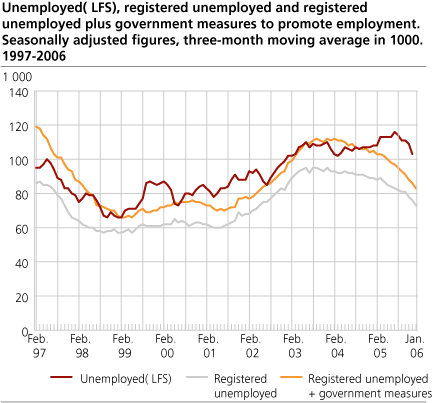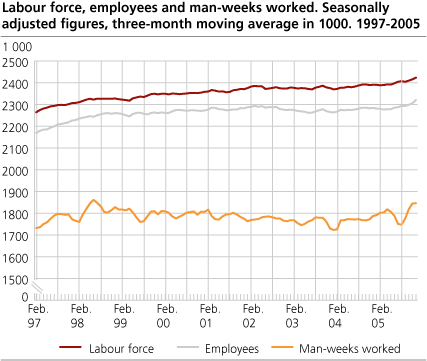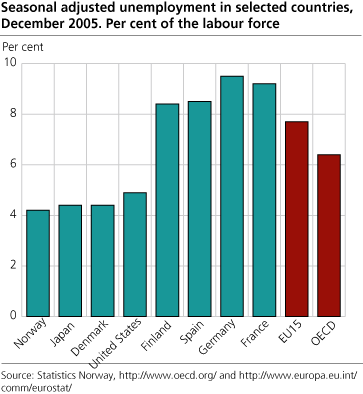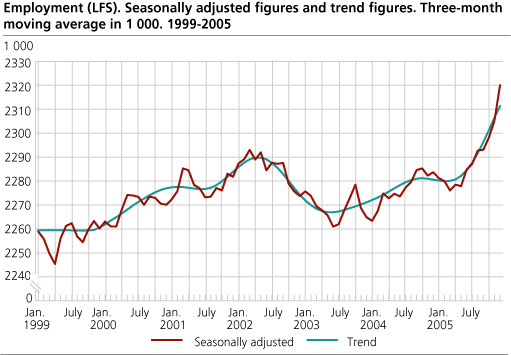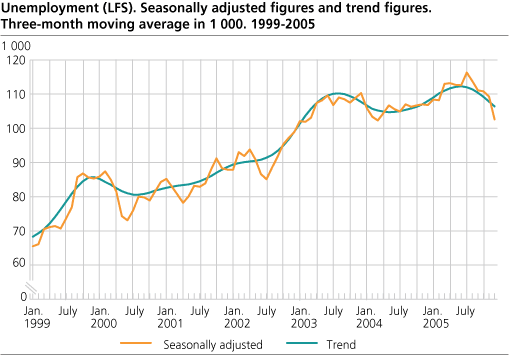Content
Published:
This is an archived release.
Employment still rising
Unemployment fell from September to December 2005, while the number of employed increased by 27 000. The figures presented in this article are adjusted for seasonal variations.
The number of unemployed in December 2005 (the November-January period) was 9 000 lower than in September (August-October). The change is outside the LFS error margin, and consistent with the downward trend we have seen in the last months. Seasonally adjusted figures of registered unemployment at job centres show a decline of 5 000 people in the same period (from September to December).
The number of employed people increased by 27 000 from September to December, according to the LFS. This is also outside the LFS error margin. Employment appears to be following an upward trend that has been seen since the summer of 2003.
With effect from January 2006, some improvements have been made in the Norwegian LFS. This will influence the seasonally adjusted unemployment, employment and man-weeks worked figures. The number of employed has been estimated to be upward adjusted by up to 2 000 as a direct effect of the change in the LFS. The effect of the changes to the unemployment figures is more difficult to measure. Some changes contribute to a downward adjustment, while others affect in the opposite direction. But the recent development previous to the time of the change in the LFS indicates only a minor overall break in the unemployment time series. The same conclusion can be drawn by comparing the LFS unemployment figures with the development of the registered unemployment at job centres. For more about the LFS, the seasonally adjustment method and the changes in the LFS, please read the various information by using the links from the left side of this page.
Unemployment up in Germany
The seasonally adjusted unemployment rate for Norway was 4.2 per cent in December 2005, compared with 4.6 per cent in September. The rate in the EU15 area stayed unchanged at 7.7 per cent, but fell in the OECD area from 6.5 to 6.4 per cent. In the same period, the unemployment went down from 5.1 to 4.9 per cent in the USA. From September to December, the unemployment rate increased from 8.3 to 8.4 per cent in Finland, while it fell from 4.5 to 4.4 per cent in Denmark, and from 9.4 to 9.2 per cent in France. In Germany there was an increase from 8.6 to 9.5 per cent, according to figures from the OECD and Eurostat .
Man-weeks worked up
From September to December, man-weeks worked went up by 71 000, which is clearly outside the LFS error margin. This must be seen in connection with a change in the vacation pattern: An unusual strong increase occurred in the number of people on vacation leave in the summer months 2005, compared with previous years. This led to an extraordinary low level of man-weeks worked in September (the August-October period). Also the man-weeks worked figures for December (the November-January average) will be extra uncertain because of the changes in the LFS. But we will be more able to measure absence from work after the LFS change. Calculations indicate a downward adjustment as a direct result of the changes made to the LFS questionnaire.
Uncertain figures
Quality tests show that the seasonally adjusted LFS unemployment figures are uncertain. The seasonal-adjustment method has problems identifying a stable seasonal pattern for this series. The random component is relatively large compared with the seasonal component. The figures should therefore be treated with caution.
The purpose of adjusting for seasonal variations is to describe the development over the last year and provide figures of change between the last two three-month periods, corrected for normal seasonal variations. In order to reduce uncertainty, the published series are three-month moving averages of the seasonally adjusted figures. For instance, the figures for December represent the average of the estimates for November, December and January.
Tables:
The statistics is published with Labour force survey.
Contact
-
Arbeidsmarked og lønn
E-mail: arbeidsmarked@ssb.no
-
Erik Herstad Horgen
E-mail: erik.horgen@ssb.no
tel.: (+47) 93 08 68 62

